Introduction
The debate whether discretionary or systematic strategies are yielding better results has been an intractable challenge for both institutional and individual investors for many years (Carver 9). Discretionary investment strategies refer to buying and selling decisions that are made at a portfolio manager’s or investment manager’s discretion (Carver 14). Therefore, discretionary investment management services are offered by professionals with Chartered Financial Analyst (CFA) designations and educational credentials of a high order (Carver 14). Discretionary investment strategies are on the other end of the spectrum, and they are referring to investment decisions made by a computer model or program with limited intervention by an investment or portfolio manager. Unlike discretionary investors who make all individual investment decisions, systematic investors only “design, monitor, and modify the automatic investment system” (Zaremba and Neumann 54).
This paper aims to compare between discretionary and systematic investment strategies. The paper will discuss the two approaches to investing in the context of hedge fund management and currency investing.
Discretionary vs. Systematic: Hedge Fund Management
Whereas discretionary funds are associated with a potential for greater returns, systematic funds are considered to be a less risky option due to a lack of involvement of human emotions in the investment decisions (Graeme 2). The majority of allocators are driven by this reasoning and, therefore, they tend to avoid systematic funds. According to Dietvorst, Simmons, and Massey, as of 2014, only 31 percent of all hedge funds were systematic (qtd. in. Campbell et al. 3). Many other reasons are usually employed to explain this gap: “systematic funds are homogeneous, systematic funds are hard to understand, the investing experience in systematic has been worse than discretionary, and systematic funds are less transparent than discretionary” (Campbell et al. 3). Some allocators argue that systematic strategies are inferior to discretionary strategies because they rely on information from the past (Campbell et al. 3). These explanations seem to fall in line with general algorithm aversion or the lack of confidence in systems. A comparison of the performance of the two investment strategies is presented in Figure 1.
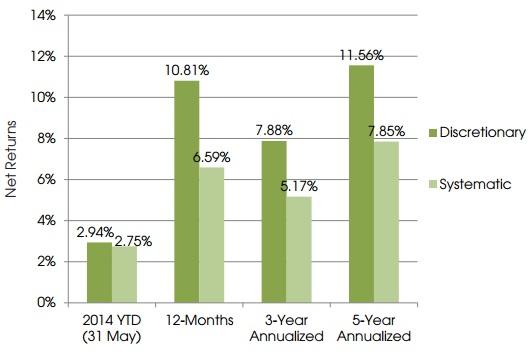
The figure shows that discretionary funds have achieved superior performance in recent years, with a 10.81 percent return over 2014 (Graeme 2). Systematic investment strategies, on the other hand, resulted only in a 6.59 percent return over the same year (Graeme 2). On an annualized basis, systematic funds have been outperformed by discretionary funds over the period from 2009 to 2014 with average returns of only 7.85 percent, which is 3.71 percent lower than that for their systematic counterparts (Graeme 2). Even though discretionary funds deliver higher returns on an annualized basis, this is not applicable across all spectrum of hedge fund strategies. Figure 2 shows the comparison between annualized returns of hedge fund strategies by different trading styles.
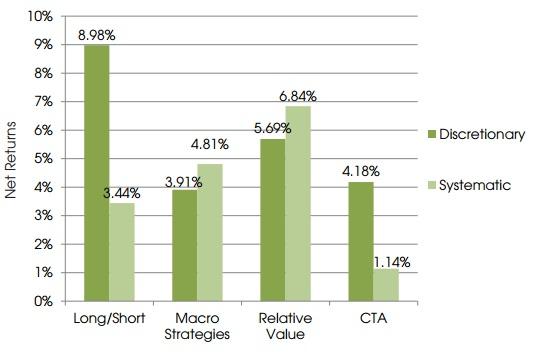
The figure indicates that returns of relative value funds outperformed discretionary funds over the period from 2001 to 2004—6.84 percent vs. 5.69 percent (Graeme 2). Systematic funds with macro strategies also show better performance—4.81 percent compared to 3.91 percent (Graeme 2). Unlike hedge fund managers who often employ a discretionary approach to fund management, commodity trading advisors (CTAs) usually rely on systematic investment strategies. In contrast to systematic hedge fund approaches, systematic strategies in commodity trading are not as successful as discretionary approaches—4.18 percent vs. 1.14 (Graeme 2). As can be seen from the table, discretionary macro funds are outperformed by systematic macro funds; however, the reverse holds for systematic equity funds and discretionary equity funds.
A recent study by Campbell et al. has compared the performance and risk exposure for the two strategies. Similarly, to the results obtained by Graeme, findings of Campbell et al.’s study show that discretionary strategies underperformed in comparison with systematic strategies (3). The study has compared the performance of the following strategies: systematic macro, systematic equity, discretionary equity. The researchers have analyzed more than 9,000 different funds over 18 years (Campbell et al. 3). The funds have been classified based on an analysis of their descriptions. For bifurcation of the funds, the following words were used for a systematic category: algorithm, approx., model, computer, statistical, and system (Campbell et al. 4). If a description of a fund contained none of these words, funds were placed in a discretionary category. Table 1 presents the main results of the study.
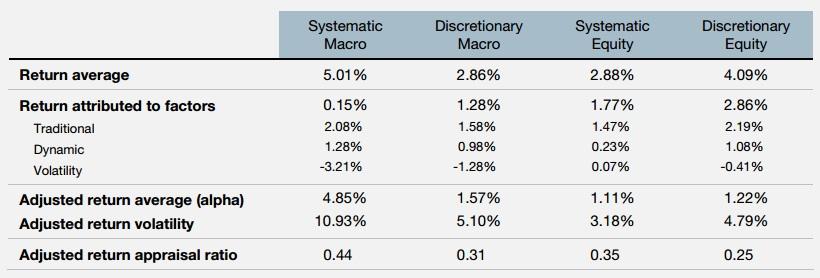
The first row of the table shows the unadjusted return for the four stiles: 5.01 percent for systematic macro, 2.86 percent for discretionary macro, 2.88 percent for systematic equity, and 4.09 percent for discretionary equity. All returns are “more than the local short-term interest rate” (Campbell et al. 3) and are annualized. The second, third, fourth, and fifth rows of the table show how the return is attributed to three types of risk factors: traditional factors such as equity, bond, and credit; dynamic factors such as stock value, size, and momentum; and a volatility factor (Campbell et al. 3). The volatility factor refers to “a strategy of buying one month, at-the-money S&P 500 calls and puts (i.e., straddles) at month-end and letting them expire at the next month’s end” (Campbell et al. 3).
As is evident in the table, the rate of return for traditional factors is positive because it ranges from 1.5 percent to 2.2 percent (Campbell et al. 3). The same can be said about dynamic factors—0.2 percent to 1.3 percent (Campbell et al. 3). However, the rate of return associated with the volatility factor is less than zero for both types of macro funds and almost zero for equity funds (Campbell et al. 3). It has to do with the fact that both systematic and discretionary macro funds are exposed to the volatility factor for a longer period than equities, which results in negative returns. This assertion is echoed in Graeme’s study—discretionary funds are associated with higher volatility than their systematic fund counterparts (Graeme 3). Figure 3 shows a comparison of rolling volatility for discretionary and systematic hedge funds.
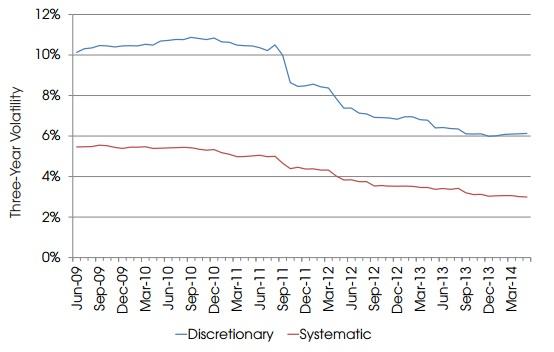
As can be seen in the figure, over the period from 2009 to 2014, discretionary strategies resulted in more volatile funds than systematic strategies—6-11 percent compared to 3-5 percent (Graeme 3). With risk-adjusted returns, systematic strategies have outperformed discretionary strategies over the same period: Shapiro rates are 1.82 vs. 1.54 percent (Graeme 3).
Having analyzed the performance trends of these two approaches to investing, it is necessary to examine how they influence fund launch activity. Taking into consideration the fact that “the majority of hedge funds adopt a discretionary approach to investing to utilize the ability of their portfolio managers” (Graeme 4), there is no surprise that there is a substantial gap between fund launches. The comparison of discretionary and systematic hedge fund launches is presented in Figure 4.
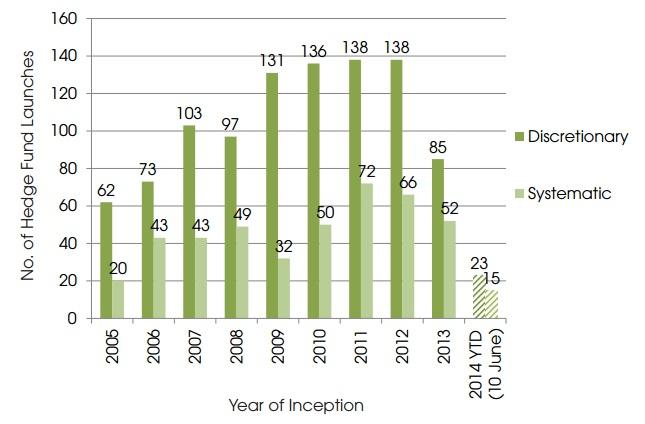
The figure shows that there is a difference between the two numbers; however, the gap has narrowed by so discretionary fund launches in the period from 2012 to 2013 (Graeme 4).
Discretionary vs. Systematic: Currency Investing
Systematic Strategies
Since the start of the current floating-rate regime in the early 1970s, economists have been struggling to develop economic models that can predict currency fluctuations (Akant 7). The difficulty of modeling currency movements can be observed by analyzing and comparing nominal exchange rates to purchasing power parity (PPP) valuations (Akant 7). It can be argued that exchange rates are not consistently bound by standard economic rules. According to Akant, “none of the economically or fundamentally derive data by themselves can generally be reliable and universal rules for trading currency” (8).
High-speed computing has allowed using systematic investment models for approaching complicated investment decisions. Even though these models or sets of predetermined rules are adaptive, fundamental inputs defining a mechanism of adaptation can be considered a predetermined rule. Nonetheless, systematic investment models can act on technical inputs analyzing even such data as quantitative parameters of textual information presented in business articles. The complexity level of such technical inputs can be extremely high, thereby allowing models to function with a wide range of historical data (Akant 7). However, even though it is easy to assume that more complicated models will perform with a higher degree of excellence, it is not always the case. The good performance of a model in the past usually translates into poor performance in the future. The main quantitative element of the most systematic models is risk management. According to Akant, it can be manifested in the form of “rebalancing the positions traded either progressively or with hard stops when losses occur” (8), thereby preserving the capital. Just like discretionary models, their systematic counterparts use recent data to respond to changing conditions.
Discretionary Strategies
The currency market is associated with exceptional liquidity. It has to do with the fact that transaction costs are low and currencies can be traded in large quantities (Akant 9). Taking into consideration the size and liquidity of the market, one can assume that currency alpha is not possible; however, the practice shows that many currency managers are actively exploring profit potential. Their ability to add value hinges on unique features of currency markets—the large portion of currency flows is comprised of the movement of goods and services, business activities, reserve management, and tourism among others (Akant 9).
The group of people who are willing to explore the profit potential of currency markets constitutes a tiny fraction of the overall currency market; therefore, it can successfully add value. Discretionary strategies for the market can be thought of as “time-varying risk allocation between well-understood currency beta factors where the weights can change based on the judgment” (Akant 10). Experienced and skilled currency managers that rely on a discretionary approach can make a reasonable judgment about market themes and relevant environmental factors. Such skills and experience can provide currency managers with a competitive edge over their colleagues who utilize a systematic approach.
Unlike systematic strategies, discretionary strategies are more adaptable to sudden changes in either the market economy or the global economy (Carver 24). Discretionary strategies are characterized by decision factors and quantitative approaches amassed by investors over time. These elements of experience can provide managers utilizing a discretionary process with a high degree of flexibility. It is especially important in times when markets are under stress or economic environments are rapidly and unpredictably shifting (Carver 24).
Systematic strategies, on the other hand, are more rigid. When it comes to the degree of sophistication, there are no models that can be compared to the skilled manager’s mind in terms of pattern recognition. However, even though experienced currency managers are more adept at assessing and foreseeing some elements of market environments, sufficiently sophisticated computer algorithms are seen by some investors as less-risky alternatives (Carver 24). Indeed, systematic strategies rely on rule-based approaches that can be easily explained to investors or fund fiduciaries. In reality, discretionary strategies work far better when applied to currency markets than their systematic counterparts that often stop working after implementation (Carver 27). Table 2 shows a comparison between the two investment strategies.
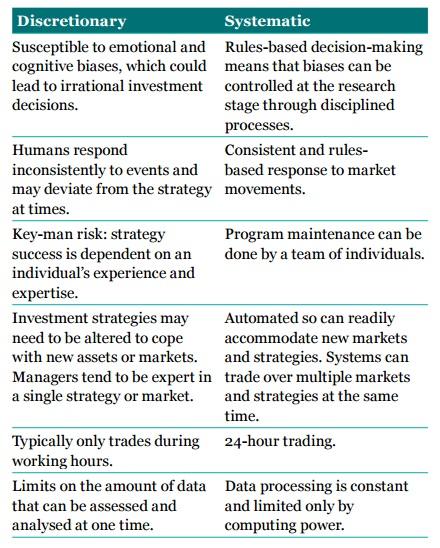
Conclusion
The paper has presented a comparison between discretionary and systematic investment strategies and discussed the two approaches in the context of hedge fund management and currency investing. The paper has shown that the belief that systematic strategies are associated with bad performance has no grounding in reality.
Works Cited
Akant, Adnan. “A Discretionary Approach to Currency Investing.” Docfinder, Web.
Campbell et al. “Man vs. Machine: Comparing Discretionary and Systematic Hedge Fund Performance.” SSRN. 2017, Web.
Carver, Robert. Systematic Trading: A Unique New Method for Designing Trading and Investing Systems. Harriman House Limited, 2015.
Graeme, Terry. “Discretionary vs. Systematic: Two Contrasting Hedge Fund Approaches.” Hedge Fund Spotlight, vol. 14, no. 1, 2014, pp. 1-4.
PLSA. “Systematic Investing: Made Simple Guide.” PLSA. 2016, Web.
Zaremba Adam, and Iver Neumann. The Financialization of Commodity Markets: Investing During Times of Transition. Springer, 2015.